Hello, I am here to share my latest obsession! Getting lots of yarn for very little money through yarn salvage and recycling…….. what’s not to like?!
This project started with me worrying about the cost of the yarn I am using to develop projects and patterns for the blog. Even using cheaper yarns like my well loved Drops Paris, the cost mounts up when you are making a large blanket. Crochet seems to ‘eat’ far more yarn than knitting, or is that just me?
I gave some thought to sources of cheap yarn and began to wonder about Charity shops/Thrift stores and yarn salvage.
Yarn Salvage and recycle!
After a bit of research I can tell you that woollen/knitted garments typically cost between £2 and £5 in these outlets. If the yarn could be salvaged that would be quite a lot of yarn for a very low cost. One problem is that it is the wrong season currently with warmer temperatures shops are not selling much knitwear but we still managed to find some candidate garments.
I say we because I decided to rope my Mum into this project. I remember from my childhood that she really enjoys undoing knots and taffles. Turns out Mum also quite likes rummaging through Charity/Thrift shops for bargain items of knitwear! A knitter herself for many years Mum understands the construction of garments. This is a big help when choosing pieces for yarn salvage.
We are now some way into our project. Mum has sourced some 15 garments and we have learned which types work best and the types to avoid. Here are our tips for garment selection.
TOP TIPS for Garment Selection when Recycling yarn
1. Look at the washing label – that gives you the yarn type, % composition wool, acrylic etc. This info is normally on the reverse of the label
2. Inspect the seams. The shoulders will normally be overlocked (zigzag stitching over both joined edges on the inside of the seam). This isn’t a problem but if you see this type of seam elsewhere on the garment this usually means the knitted fabric has been cut and joined which means there will be a break in the yarn on every row. This gives very short lengths of yarn. Avoid!
3. Unless you fall in love with a particular yarn, go for jumpers rather than jackets/cardigans. Jumpers are normally easier to unpick. Jackets and cardigans can be very difficult to deal with where the front band is attached and again are sometimes cut, resulting in short lengths of yarn.
4. Look at the texture. Unravelling thicker yarn is generally easier than the finer ones.
5. Large garments often cost the same as smaller ones as pricing tends to be per garment. The larger the garment the greater the quantity of yarn you can recover!
Read on for more tips on garment selection
6. Charity shops are seasonal. Many will not display knitted garments in summer but it is always worth a look. Lighter weight items will probably still be available.
7. One you have a stock, bear in mind the colours and weight of your yarns – look for items you can combine.
8. Shops have sales. Even though these outlets are incredibly cheap to start with there are times when they discount. There are also sometimes discount rails where items have been in store for a time and not sold. Keep an eye out for sales!
9. Make sure you are looking in the right kind of shop. Shops selling vintage or retro garments will be selecting stock based on the style and age of the garment and will be charging a much higher price than the average Charity Store.
10. Do not be put off by the style of a garment. You will not be wearing it! An item that is not attracting buyers in its current form might be made of very attractive yarn!
Recovering the yarn
We also learnt how best to recycle the yarn and to work out what to do with the yarn we recovered. I will cover these in a later post.
The first few garments we bought are shown in the photos below. When you start to take the garments apart you have to be very careful not to snip the yarn. However, if you do snip the yarn in error it just gives shorter lengths or smaller balls which can still be used – depending on the project you select.
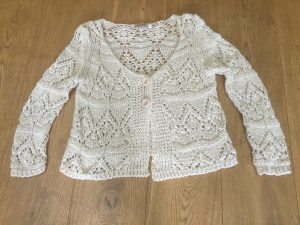
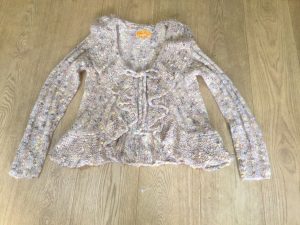
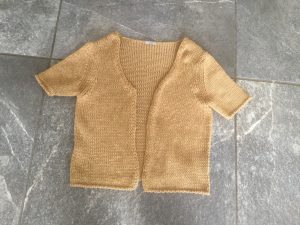
Yarn Salvage – Unpicking the garments
The first garment we unpicked was the flecked cardigan. This one gave me the inspiration for a blanket project. We picked creams and browns to go with it and unpicked the other two garments shown. These photos show the quantity of balled yarn we ended up with. More than 1kg of yarn for £6, not bad eh? On the subject of money a bit of small print I am obliged to share. Adverts and banners in this post are affiliate links. If you click on them I might receive a small payment which supports my blog and allows me to keep posting. Right – on to the interesting stuff. CHEAP YARN and free patterns!!
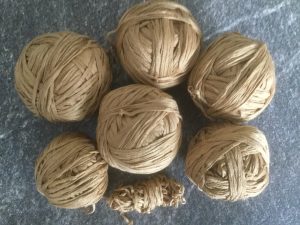
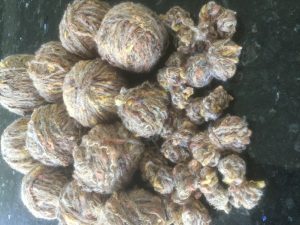
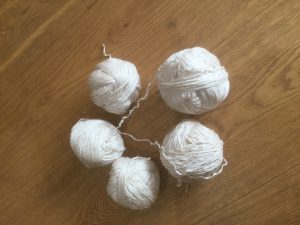
The yarn is more or less Aran weight. I will include more on how to identify the weight in the next post. I used to have an obsession with knitting cabled sweaters so have a lot of oddments of plain aran yarn in my stash. Some of the oddments were in similar colours to the yellow/orange flecks in the ‘inspiration’ yarn. I put these oddments from my stash with the salvaged yarn to give me a large enough quantity to produce a blanket.
Yarn Salvage – Using the recycled yarn!
Next in my yarn salvage project, I came up with a block pattern that I can scale up and down to make three different sizes of square. The pattern(s) are shown at the bottom of the post. These are some of the blocks I have completed so far.
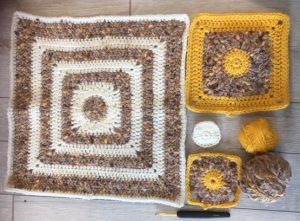
Finally, turning this blanket into a whole family project, my husband designed a layout for the blocks.
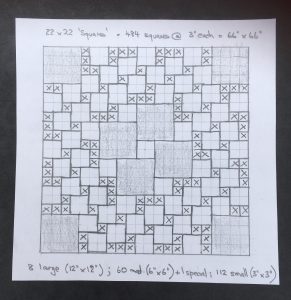
Here are the patterns I am using for the three sizes of block. I might need to amend these when it comes to stitching up if the weights of the yarn result in size differences. I will either block them to the correct size or add additional rows to increase the size! The change of colour instruction in these patterns shows you how I am working – you can change colour whenever you like or make the blocks solid colour. It really depends on the yarn you have from your own yarn salvage project.
Instructions in UK terms – please SCROLL DOWN for US terms
Large Square – UK terms

Change colour
Change colour
Change colour
Change colour
Change colour
Change colour
Change colour
Medium sized square – UK terms

Change colour
Change colour
Small Square – UK terms
Change colour
Change colour
Instructions in US terms – please SCROLL UP for UK terms
Large Square – US terms

Change Colour
Change colour
Change colour
Change colour
Change colour
Change colour
Change colour
Medium sized square – US terms

Change colour
Change colour
Small Square – US terms
Change colour
Change colour
And that is it from me. I hope you enjoy rooting around for knit wear to recycle and yarn salvage! Please share your stories. Happy crocheting!
Annie 🙂